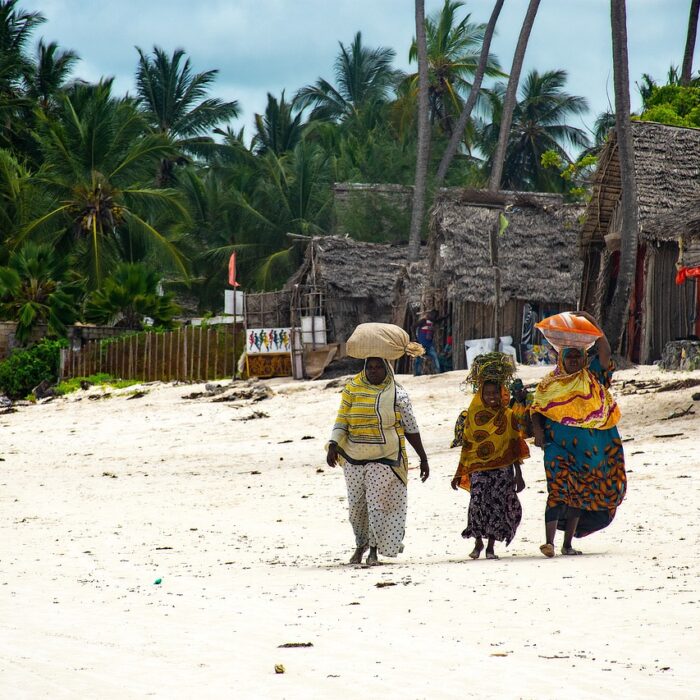
Unveiling Tanzania Beyond Wildlife
Apart from wildlife, a photo safari can be even more interesting when exploring the vibrant tapestry of Tanzanian cultures. Through the lens, you can witness the Maasai people traversing the Great Rift Valley, adorned in vibrant shukas, as they gracefully tend to their cattle. From ornate beaded jewelry and ear piercings to traditional villages (bomas) and the ethereal landscapes they call home, each frame weaves a narrative of resilience and tradition.
On the shores of Lake Victoria in the north, photographing the vibrant markets and fishing villages of the Wazobia people offers an entirely different cultural experience. The contrast between the thatched roof houses, dugout canoes, and dried tilapia fish against the serene beauty of Africa’s largest lake makes for engaging photographs.
Venture into the towering mountains surrounding Mount Kilimanjaro, where the Chagga people have cultivated and irrigated their fertile farmland for centuries.Through photography, you can capture their agricultural and woodcutting practices against the backdrop of unique architecture, nestled in the lush foothills and framed by the snow-capped peak soaring 19,000 feet (5,895 meters) above. Each photograph unveils the Chagga people’s profound connection to the iconic mountain landscape, portraying a story etched in the very soil they cultivate.
These cultural chronicles extend an invitation to explore Tanzania beyond the wildlife, capturing moments that celebrate heritage, resilience, and the intricate relationships between diverse communities and their awe-inspiring landscapes.
Photographing Local Communities and Landscapes
Exploring beyond its wildlife, Tanzania reveals a rich blend of cultures woven into its landscapes. It is the photographer’s responsibility to honor local communities while capturing and preserving their heritage.
-
Seek Permission: Always request consent before photographing people, especially for close-up portraits. Be gracious if they decline.
-
Honor Customs: Research to understand cultural traditions. Avoid taking intrusive photos that could be disrespectful.
-
Tread Lightly: Practice environmental awareness to leave no trace behind. Never disrupt wildlife or landscapes.
-
Convey Stories: Photograph daily rituals that convey the spirit of the community. Portray their connection to the land.
-
Connect Respectfully: Friendly engagement strengthens cultural insight. Often, natural interactions lead to more authentic frames.
-
Consider Thoughtfully: Analyze if the photographs appropriately represent the community without perpetuating stereotypes.
By following these tips, photographers can enhance their skills in capturing the essence of Tanzania’s wildlife and landscapes, while also respecting the local communities and environment.
Preparing for Your Photo Safari in Tanzania: Tips and Tricks
Embarking on a photo safari in Tanzania promises a thrilling adventure and a treasure trove of photographic opportunities. To ensure you make the most of this unique experience, here are some invaluable tips and tricks to help you prepare:
-
Research and Plan Ahead
Before you even pack your camera, dive into researching the diverse landscapes and wildlife Tanzania has to offer. Familiarize yourself with the specific regions and national parks you’ll be visiting. This groundwork ensures you’re well-prepared to capture the essence of each location.
Understand the Local Climate:
-
Dry Season (June to October): Characterized by comfortably warm days and cool nights. Minimal rainfall; short grass
-
Wet Season (November to May): Includes the short rains (November to December) and the long rains (March to May). Expect afternoon showers and lush landscapes with tall grass
Tanzania’s climate varies, so choose your safari timing wisely. The dry season (June to October) is excellent for wildlife viewing as animals gather around water sources. If you’re interested in the river crossings of the Great Migration, plan your safari between the end of July and September.
2. Gear Check: Camera Essentials
Make a comprehensive checklist of your camera gear. Essential Gear and Equipment include
-
Camera Gear: Bring a reliable DSLR or mirrorless camera with manual settings for flexibility in various shooting conditions.
-
Lenses: A versatile lens kit is crucial. A telephoto lens (70-300mm or longer) is essential for wildlife close-ups, while a wide-angle lens captures expansive landscapes.
-
Sturdy Tripod: Ensure stability for longer exposures and sharper images, especially during low-light conditions. We provide beanbags in the vehicle.
-
Camera Bag: Invest in a durable and comfortable camera bag to protect your gear from dust and weather.
-
Binoculars: Enhance your safari experience by spotting distant wildlife and potential photo subjects.
3. Master the Art of Wildlife Photography
Study the behavior of the wildlife you’re likely to encounter. Patience is key – be prepared to wait for that perfect shot. Practice using your camera’s burst mode for capturing dynamic animal movements, and familiarize yourself with manual settings to adapt quickly to changing lighting conditions.
4. Choose the right clothing
In addition to your photography equipment, pack essentials such as comfortable clothing such as:
-
Layered Clothing: Lightweight, breathable fabrics for daytime; warm layers for cool mornings and evenings.
-
Protection Gear: A wide-brimmed hat, sunglasses, and a high SPF sunscreen to protect against the sun.
-
Footwear: Durable, comfortable walking shoes or boots for uneven terrain.
-
Rain Gear: Waterproof jacket or poncho for the wet season.
-
Neutral Colors: Choose colors that blend with the environment like khaki, brown, and green.
5. Connect with Local Guides
Engage with experienced local guides who have an intimate knowledge of the terrain and wildlife behavior. They can provide valuable insights and get you in the right position for the perfect shot, enhancing your photographic journey. Local guides also contribute to sustainable tourism practices, ensuring minimal impact on the environment.
6. Respect Wildlife and Local Communities
Maintain a respectful distance from wildlife to avoid disturbing their natural behavior. Be mindful of local customs and seek permission before photographing people, villages, or cultural events. Responsible photography contributes to a positive impact on both wildlife and communities.
7. Backup and Protect Your Photos
Carry extra memory cards and backup your photos regularly. Consider a portable hard drive or cloud storage to ensure your precious memories are safe. Additionally, protect your camera equipment from dust and sudden weather changes with appropriate covers.
8. Connectivity:
-
International SIM Card or Local SIM: For staying connected, consider international plans or buying a local SIM card.
-
Power Adapters: Bring appropriate power adapters and converters for charging devices.




